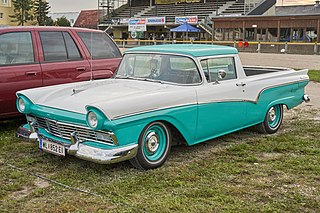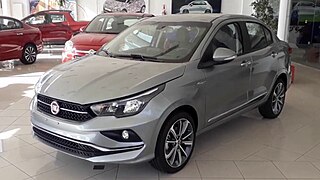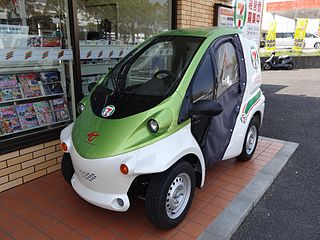Related Research Articles

The Citroën Berlingo and Peugeot Partner are a range of multi-purpose vehicles produced by the PSA Group and later by Stellantis. They are sold both as panel vans for use as commercial vehicles and as a passenger variant with rear seats and windows. The third generation is also sold as the Opel/Vauxhall Combo, as the Toyota ProAce City from 2019 and as the Fiat Doblò from 2022.

The Ford Ranchero is a coupe utility that was produced by Ford between 1957 and 1979. Unlike a standard pickup truck, the Ranchero was adapted from a two-door station wagon platform that integrated the cab and cargo bed into the body. A total of 508,355 units were produced during the model's production run. Over its lifespan it was variously derived from full-sized, compact, and intermediate automobiles sold by Ford for the North American market.

Zeta is a marque of automobile which was produced in Australia from 1963 to 1965 by South Australian manufacturing company Lightburn & Co.

The Ford Transit Connect is a compact panel van sold by Ford since 2002. Developed by Ford of Europe, the model line replaced sedan-based vans with a dedicated commercial vehicle platform. The model line is the second-smallest vehicle of the Ford Transit range, slotted between the Ford Transit Courier LAV and the Ford Transit Custom LCV/MPV. In line with other Ford Transit variants, passenger-oriented models are marketed as the Ford Tourneo Connect with side windows and rear seats.

The CitiCar is an electric car produced from 1974 to 1977 by Sebring, Florida–based Sebring-Vanguard, Inc. After being bought out by Commuter Vehicles, Inc, Sebring-Vanguard produced the similar Comuta-Car and Comuta-Van from 1979 to 1982. Similarities to its exterior design can be spotted in the Danish Kewet and the later Norwegian Buddy electric car. Accounting for all CitiCar variants, a total of 4,444 units were produced up to 1979, the most since 1945 for an electric car assembled in North America until surpassed in 2011 by the Chevrolet Volt.

Industrias Kaiser Argentina S.A. was an Argentine automobile manufacturer established in 1956 as a joint venture with Kaiser Motors of the United States. Headquartered in Santa Isabel, Córdoba, the automaker produced a variety of Kaiser Jeep vehicles and American Motors Corporation (AMC) models, including Argentina's most iconic car, the Torino, before partnering with France's Renault, which bought it out in 1970.

The ZAP Xebra was an electric car launched in May 2006 in the United States market by ZAP corporation. It is classified legally as a three-wheel motorcycle in some jurisdictions, and is available in both sedan and pickup truck variants. It has seat belts. It does not have regenerative braking. The PK pickup has a dump bed, with fold-down sides and tailgate, that allows easy access to the batteries, controller, motor, and charger.

Ford Argentina S.C.A. is the Argentine subsidiary of Ford Motor Company founded in Buenos Aires in 1913. Its first products were Model Ts assembled from complete knock down (CKD) kits provided by Ford Motor Company in 1917. Nevertheless, Ford Motor Argentina is best known in more recent times for producing the Ford Focus and, previously, the Argentine version of the Ford Falcon, originally a U.S. model introduced in Argentina in 1961, but adapted to the Argentine market.

Baojun is a Chinese automobile marque owned by a joint venture of General Motors and SAIC Motor, SAIC-GM-Wuling Automobile.

The Renault Twizy is a two-seat electric microcar designed and marketed by Renault. It is classified in Europe as either a light or heavy quadricycle depending on the output power, which is either 4 kW (5.4 hp) for the 45 model or 13 kW (17 hp) for the 80 model, both names reflecting its top speed in km/h. Originally manufactured in Valladolid, Spain, production was moved to Busan in South Korea in March 2019 to meet increased demand in Asia.

The Fiat Tipo is a compact car. A three-box sedan version was unveiled at the 2015 Istanbul Motor Show in May 2015, and commenced sales in Turkey in October 2015.
The Sôki was a two-seat three-wheeled microcar battery electric vehicle produced by the Chilean manufacturer Voze EV with the support of CORFO. It is the only electric vehicle aimed at commercial mass production in Chile and the second vehicle to be built by Voze after the company's first prototype Lüfke in 2014. It is a for urban use. Its aim was to combine the advantages of three vehicles, the comfort and security of a car, the agility and homologation of a motorcycle and the ecology and economy of a bicycle.

The Porsche Taycan is a battery electric saloon and shooting brake produced by German automobile manufacturer Porsche. The concept version of the Taycan, named the Porsche Mission E, debuted at the 2015 Frankfurt Motor Show. The Taycan was revealed fully production-ready at the 2019 Frankfurt Motor Show. As Porsche's first series production electric car, it is sold in several variants at different performance levels, and may spawn further derivatives in future models. More than 20,000 Taycans were delivered in 2020, its debut sale year, representing 7.4% of the total Porsche volume. A modified Taycan S is the current Formula E Safety car.

The Fiat Cronos is a subcompact car released in February 2018 by the Italian automaker Fiat. It is a sedan for the Latin American market based on the Argo hatchback.

The Baojun E200 is an electric two-seater microcar, with two doors and a hatch at the rear. It is the second vehicle in Baojun's electric microcar series, after the E100 and before the E300. Since 2021, it is also known as the Wuling Nano EV.

General Motors de Argentina S.R.L. is the Argentine subsidiary of the US-based company General Motors. The company is currently headquartered in Vicente López, Buenos Aires, with its factory located in Alvear, Santa Fe Province.

The Baojun E100 is an electric two-seater microcar by Baojun, with two doors and a hatch at the rear. It is the first vehicle in Baojun's electric microcar series.

The Toyota COMS is a single-seater electric microcar produced by Toyota Auto Body. The first generation was produced by Araco in 2000. In 2012, Toyota Auto Body launched a second generation.

Mercedes-Benz Argentina S.A.U. is the Argentine subsidiary of international conglomerate Mercedes-Benz Group which produces and markets Mercedes-Benz utilitary vehicles in the country. The company was established in 1951 and has its assembly plant in Virrey del Pino, La Matanza Partido, where trucks and buses has been produced. Furthermore, MBA imports a wide range of luxury automobile models including sedans, SUVs, and AMG Performance cars.
Sero electric is an Argentine electric microcar manufacturer based in Buenos Aires, founded in 2010.
References
- 1 2 "Sero Electric: lanzamiento en Argentina, desde U$S 9.900". www.16valvulas.com.ar (in Spanish). Retrieved 7 January 2022.
- 1 2 "Lanzamiento: Sero Electric Cargo Bajo y Furgón". Motor1.com (in Spanish).
- ↑ "El Sero Electric ya tiene fecha: en 2018 llega el primer vehículo eléctrico argentino". LA NACION (in Spanish). 6 July 2017.
- ↑ "Movi Electric" (PDF) (in Portuguese). Movi Electric. Retrieved 7 January 2022.
- ↑ "Sero: The First Argentine Electric Car Began To Be Manufactured" . Retrieved 7 January 2022.
- ↑ "Sero Electric: el auto 100% eléctrico y argentino". Autocosmos (in Spanish). 11 August 2017.